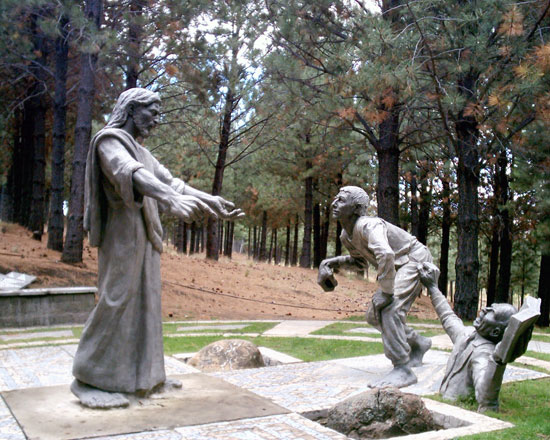Another way to Christ: Via Christis in Junín de los Andes See map
The Via Christis (Christ's way) is a ritual of Christian origins which calls both for its spiritual significance as for its artistic richness. Junín de los Andes is the paradigm of the festival, with a Via Christis brings together elements of Catholic and Mapuche traditions.
 One of the stations of the Via Christi in Junín de los Andes. Photo courtesy of Carlos from photo album www.patagonia.com.ar
One of the stations of the Via Christi in Junín de los Andes. Photo courtesy of Carlos from photo album www.patagonia.com.ar
Junin de los Andes is a point of reference in the celebrations of Easter. From the year 2000 it was growing in this city an ambitious project of Via Christis focused on a historical Christ, in the context of own intercultural of the place where different cultures come together as Christian and Mapuche.
The end result was a 2.5-kilometer circuit that annually travel thousands of people, both locals and visitors. In its fifteen seasons it recreates the life, work and passion of Christ, as the main activity of Holy Friday.
The tour begins at the foot of La Cruz Hill and ends at its the summit, ruled by a white cross. All the way is accompanied by impressive works of religious art, designed by architect Alejandro Santana. The guides are responsible for publicizing the various meanings of each station that represent a different stage in the life of Jesus:
- Station 1: Jesus teaches the Beatitudes.
- Station 2: Jesus and children.
- Station 3: Jesus multiplies the loaves and fishes.
- Station 4: Jesus heals the man born blind.
- Station 5: Jesus washes the feet of his disciples.
- Station 6: Jesus in the Garden of Gethsemane.
- Station 7: Jesus is betrayed by Judas.
- Station 8: Jesus is scourged.
- Station 9: Jesus carries the cross.
- Station 10: Jesus is stripped of his clothes.
- Station 11: Jesus, Mary and John the Beloved.
- Station 12: Jesus is taken down from the cross.
- Station 13: Jesus is resurrected.
- Station 14: Jesus meets Mary Magdalene.
- Station 15: Jesus sends the disciples (with Mary and the Holy Spirit). Jesus and the Trial of the nations.
The whole route is constructed of natural materials. There is a bridge of logs and a natural spring that originates on the mountain, symbolizing the origin of life. Recently this road was adapted for elderly and disabilities so they can also enjoy the ritual.
Strong traditions
Part of the religious offer for visitors of Junín is treasured in the Mapuche Municipal Museum, which stands on the street Gines Ponte since its inception in 1988. Its responsibility at the beginning was the priest Marchesotti Pascual, a native of Carmen de Patagones (Buenos Aires province). He collected many of the exhibits, in successive trips to Patagonia and he was who specifically requested to be carried to Junín, for being a place with strong presence of Mapuche culture. There you can see archaeological and anthropological elements, as well as geological and paleontological objects, all from different areas of the province of Neuquén.
Among other things exposed are musical instruments (like the sacred cultrúm), crafts, maps, native species of plants and animals stuffed, utensils (mortars, bows, arrows, balls, spoons), necklaces, bronze and silver (very significant material for the Mapuches), engraving, stone pipes, clay or mud, stones, tableware, as well as dinosaur bones found in the area of Cutral-Có. Admission to the museum is free and it is open Monday through Friday from 9 to 12 and 15 to 20 hours.
Leaving town on Provincial Route 23 and after traveling 17 kilometers you access Malleo river bridge, where the road forks. If the tour continues to the east (always bordering the river) you can reach the settlement of the Mapuche Community Painefilú. The members of this community receive visitors with activities of their tradition. Visitors can camp, buy crafts, taste fried cakes, homemade bread, roast lamb or choose between horse riding and sport fishing.
Viajes por la Patagonia
Related Articles
© Patagonia.com.ar 2025 | Todos los derechos reservados.
